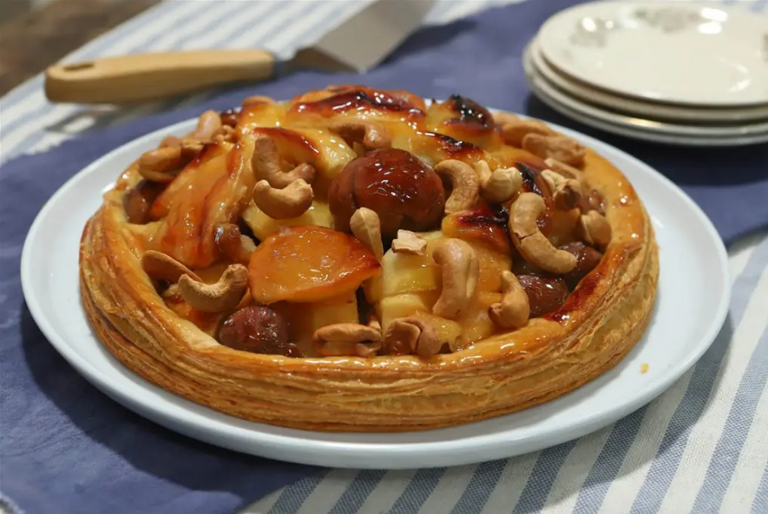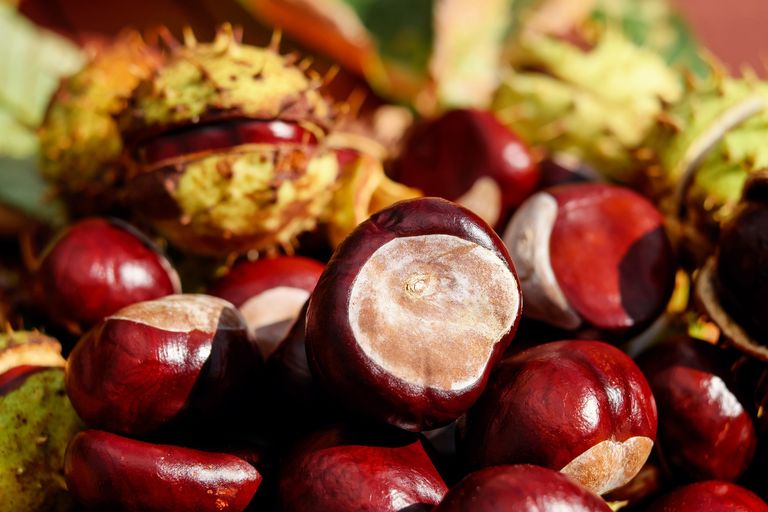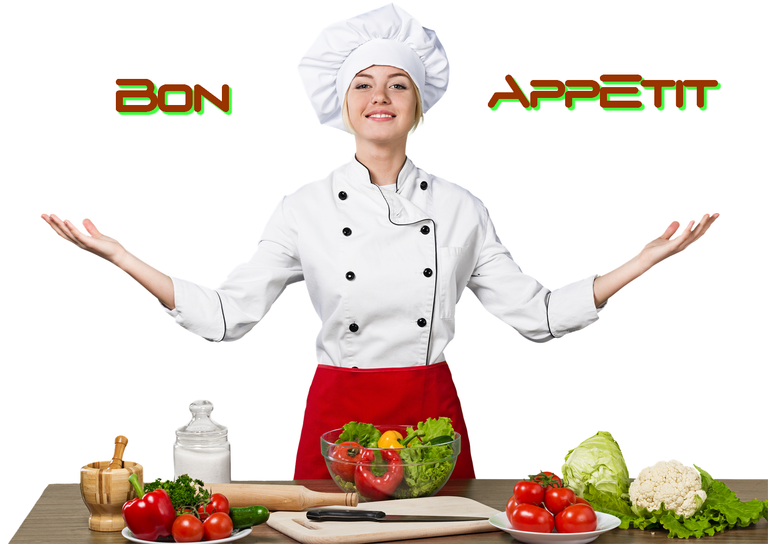
Very good Sunday to all my #blurtians friends who love good cooking, “l'arte di mangiar bene” (the art of eating well) as Pellegrino Artusi said, author of the first and true treatise on cooking.
Today I want to propose a delicious chestnut cake with the addition of apples.
Muy buen domingo para todos mis amigos #blurtians amantes de la buena cocina, "l'arte di mangiar bene" (el arte de comer bien) como decía Pellegrino Artusi autor del primer y verdadero tratado de cocina.
Hoy les quiero proponer una deliciosa torta de castañas con el agregado de manzanas.
Recipe for persons n. 6
Note: 685 calories per serving
SEPARADOR
Receta para personas n. 6
Nota: 685 calorías por porción
Ingredientes
- 250 g flour
- 120 g butter
- 40 g of powdered sugar
- 700 grams of cooked and peeled chestnuts
- 3 delicious apples
- 80 g granulated sugar
- 6 dl of milk
- 1 vanilla pod
- 1 dl fresh cream for
- one tablespoon of apricot jelly * one tablespoon of apricot jelly
- salt
SEPARADOR
- 250 g de harina
- 120 g de mantequilla
- 40 g de azúcar glas
- 700 g de castañas cocidas y peladas
- 3 deliciosas manzanas
- 80 g de azúcar granulada
- 6 dl de leche
- una vaina de vainilla
- un dl de nata fresca para
- montar una cucharada de gelatina de albaricoque
- sal
Elaboración:
30' + 2 hours of baking time / 30' + 2 horas de cocción
- Mix in a bowl the flour with the powdered sugar (except one tablespoon), a little salt, 100 g of butter and one egg.
- Mix until a homogeneous dough is obtained.
- Wrap it in cling film and let it rest in the refrigerator for 30 minutes.
- Pour the milk into a saucepan, add the vanilla pod cut lengthwise and the chestnuts and bring to the boil.
- Drain and reserve 8 chestnuts; cook the rest for 10 minutes and let them cool.
- Peel 2 apples and cut into slices; Melt the rest of the butter in a pan, add the apples and cook over medium heat for 5-6 minutes.
- Blend half of the cooked chestnuts in the milk with the sugar, cream and remaining egg, pour the mixture into a bowl with the cooked apples.
- Roll out the shortcrust pastry to a thickness of half a centimeter.
- Line a non-stick tart pan 18 cm in diameter with high edges.
- Prick the bottom with a fork and distribute the reserved chestnuts (except a few).
- Cover them with the chestnut mixture and arrange the remaining sliced apple on the surface.
- Bake the cake in the lower part of the preheated oven at 180° for about 50 minutes, let it cool and unmold.
- Decorate with the reserved chestnuts and brush the surface of the cake with the apricot jelly melted in a saucepan over low heat.
- Serve the cake cold and sprinkle with powdered sugar.
SEPARADOR
- Mezclar en un bol la harina con el azúcar glas (excepto una cucharada), un poco de sal, 100 g de mantequilla y un huevo.
- Mezclar hasta obtener una pasta homogénea.
- Envuélvelo en film transparente y déjalo reposar en el frigorífico durante 30 minutos.
- Echar la leche en un cazo, añadir la vaina de vainilla cortada a lo largo y las castañas y llevar a ebullición.
- Escurrir y reservar 8 castañas; cocina los demás por 10 minutos y déjalos enfriar.
- Pela 2 manzanas y córtalas en rodajas; Derrite el resto de la mantequilla en una sartén, agrega las manzanas y cocínalas a fuego medio durante 5-6 minutos.
- Licua la mitad de las castañas cocidas en la leche con el azúcar, la nata y el huevo restante, vierte la mezcla en un bol con las manzanas cocidas.
- Estirar la masa quebrada hasta que tenga un espesor de medio centímetro.
- Forrar un molde para tarta antiadherente de 18 cm de diámetro con los bordes altos.
- Pinchar el fondo con un tenedor y distribuir las castañas reservadas (excepto algunas).
- Cúbrelas con la mezcla de castañas y dispone el resto de la manzana cortada en rodajas en la superficie.
- Cuece la tarta en la parte baja del horno precalentado a 180° durante unos 50 minutos, déjala enfriar y desmolda.
- Decorar con las castañas reservadas y pincelar la superficie del bizcocho con la gelatina de albaricoque derretida en un cazo a fuego lento.
- Servir el bizcocho frío y espolvorearlo con azúcar glas.

The chestnut tree, with the scientific name Castanea sativa, is a millenary plant, present in the wild in the Mediterranean area since prehistoric times, more precisely since the Cenozoic, that is, since the beginning of the distribution of broad-leaved trees on earth.
It grew in a vast area that includes all of southern Europe, some parts of Asia Minor, the northern coast of Turkey, Greece, Algeria, the Balkan peninsula, Austria up to the Carpathians. Fossils can also be found in Germany, England and Sweden, but in these regions it was imported by man.
The chestnut tree is a long-lived plant.
Even today, on the Sicilian provincial road from Sant'Alfio to Linguaglossa, a chestnut tree called “of the hundred horses” is a tourist destination because, according to legend, Queen Joan of Aragon and her hundred took refuge under its branches during a storm, which can contain an entire flock of sheep and which, according to botanist Payronal, is approximately 3 to 4000 years old.
It is considered the oldest extant in Europe and the oldest in Italy. Bosc also mentioned in the early 19th century a thousand-year-old tree which he called “Sancerre chestnut”. The English remember a chestnut tree called “the great Tortworth tree” which according to legend was much older than their King John (which is unknown), as well as a plant in Greenwich Park that was said to have been planted in the poet's house. This time Ecelyn, and one other in Kensington Park, claimed to be millennials.
Very long-lived, the chestnut tree, but slow to develop: it needs soils that are not calcareous, but deep and well-drained, it reaches its maximum splendor at fifty years, with a height varying from 25 to 35 meters, the first fruits there give about 25 years.
The consumption of chestnuts by man is large and very old: Martial (40 B.C.) states that no city could compete with Naples in roasting chestnuts, while Virgil in the second book of the Georgics recommends grafting the chestnut tree on the beech and in the Eclogues recalls the chestnuts. cooked with milk and eaten with cheese.
In 1700 appeared the marrons glacé, which were then served only at the banquets of the nobles, while later the custom spread to offer them on New Year's Eve as a wish for happiness and abundance. Also at that time, in Paris, a type of chocolate made by the pharmacist Bonneau and packaged with half the weight of cocoa and half the weight of dry roasted chestnut flour was very successful.
The chestnut remains one of the most sought-after autumn fruits, extremely versatile as it adapts to both savory and sweet preparations. What is the difference between chestnuts and browns? The first are fruits of the wild chestnut tree, each riccio contains three (that is why they are usually found without the classic convexity: it is the chestnut tree that is in the middle), while the brown comes from cultivated trees and always improved with successive Grafts, each riccio contains only one fruit. For every 100 g, the chestnut provides 250 calories, to which must be added those of eventual seasonings and sugars.
Chestnuts are also used in animal husbandry: the meat of pigs and chickens acquires better flavor and greater consistency when chestnuts and leftover flour are included in the diet.
SEPARADOR
El castaño, de nombre científico Castanea sativa, es una planta milenaria, presente en estado silvestre en el área mediterránea desde tiempos prehistóricos, más precisamente desde el Cenozoico, es decir, desde que se inició la distribución de los árboles de hoja ancha en la tierra.
Creció en una vasta área que incluye todo el sur de Europa, algunos lugares de Asia Menor, la costa norte de Turquía, Grecia, Argelia, la península de los Balcanes, Austria hasta los Cárpatos. También se puede encontrar fósil en Alemania, Inglaterra y Suecia, pero en estas regiones fue importado por el hombre.
El castaño es una planta longeva.
Aún hoy, en la carretera provincial siciliana que va de Sant'Alfio a Linguaglossa, un castaño llamado "de los cien caballos" es un destino turístico porque, según la leyenda, la reina Juana de Aragón y su centenar se refugiaron bajo sus ramas durante una tormenta, que puede contener un rebaño entero de ovejas y que, según el botánico Payronal, tiene aproximadamente entre 3 y 4000 años.
Se considera el más antiguo existente en Europa y el más antiguo de Italia. Bosc también mencionó a principios del siglo XIX un árbol milenario al que llamó "castaño de Sancerre". Los ingleses recuerdan un castaño llamado "el gran árbol de Tortworth" que según la leyenda era mucho más antiguo que su rey Juan (cual se desconoce), así como una planta en el parque de Greenwich que se decía que fue plantada en la casa del poeta. Esta vez Ecelyn, y otra más en Kensington Park, afirmaron ser millennials.
Longevísimo, el castaño, pero de lento desarrollo: necesita suelos no calcáreos, pero sí profundos y bien drenados, alcanza su máximo esplendor a los cincuenta años, con una altura que varía de 25 a 35 metros, los primeros Los frutos allí dan alrededor de 25 años.
El consumo de castañas por parte del hombre es grande y muy antiguo: Marcial (40 a. C.) afirma que ninguna ciudad podría competir con Nápoles en asar castañas, mientras que Virgilio en el segundo libro de las Geórgicas recomienda injertar el castaño en el haya y en las Églogas recuerda las castañas. cocinado con leche y comido con queso.
En 1700 aparecieron los marrons glacé, que entonces se servían únicamente en los banquetes de los nobles, mientras que más tarde se extendió la costumbre de ofrecerlos en Nochevieja como deseo de felicidad y abundancia. También en esa época, en París, tuvo un gran éxito un tipo de chocolate elaborado por el farmacéutico Bonneau y envasado con la mitad del peso de cacao y la mitad de harina de castaña seca tostada.
La castaña sigue siendo una de las frutas de otoño más solicitadas, sumamente versátil ya que se adapta tanto a preparaciones saladas como dulces. ¿Cuál es la diferencia entre castañas y marrones? Los primeros son frutos del castaño silvestre, cada erizo contiene tres (por eso se suelen encontrar sin la clásica convexidad: es el castaño el que está en el medio), mientras que el marrón procede de árboles cultivados y siempre mejorado con sucesivos Injertos, cada riccio contiene un solo fruto. Por cada 100 g, la castaña aporta 250 calorías, a las que hay que añadir las de eventuales condimentos y azúcares.
Las castañas también se utilizan en la cría de animales: la carne de cerdos y pollos adquiere mejor sabor y mayor consistencia cuando se incluyen en la dieta castañas y restos de harina.
Fuente imagen inicial . / Source initial image: el Gourmet
Fuente imagen final. / Source final image: Pixabay by Couleur..
Estas recetas y tantas otras publicadas en #BLURT las pueden encontrar en mis blogs en italiano, inglés y español. Más de 5.000 recetas para darle fantasía y color a tu mesa y hacer una figura digna de un/a chefs con tus invitados.
These recipes and many others published in # BLURT can be found on my blogs in Italian, English and Spanish. More than 5,000 recipes to give fantasy and color to your table and make a figure worthy of a chef with your guests.
Y como siempre me despido de todos con un:
And as always I bid you all farewell with a:

Mis Blogs y Sitios Web / My Blogs & Websites:
I decided to open this blog to share with others the passion I have for cooking, hence the title of the blog, there will be no shortage of classic recipes, revisited, personal and try to cover as much as possible. The recipes that you will find reflect my daily life, I hope to be able, despite my modest experience, to serve you with my advice, because whatever you decide to do, cooking requires time, love and passion.
Decidí abrir este blog para compartir con otras personas la pasión que tengo por la cocina, de ahí el título del blog, no faltarán recetas clásicas, revisitadas, personales e intentaré abarcar lo máximo posible. Las recetas que encontrarás reflejan mi vida diaria, espero poder, a pesar de mi modesta experiencia, poder servirte en mis consejos, porque decidas lo que decidas hacer, cocinar requiere tiempo, amor y pasión.

Telegram and Whatsapp
Thank you for curating, commenting and voting on my content @blurtconnect-ng.
Upvoted. Thank You for sending some of your rewards to @null. Read my last posts to make sure that BLURT burning is profitable for you. Before using this bot please make sure your account has at least 100 BP. Get more BLURT:
@ mariuszkarowski/how-to-get-automatic-upvote-from-my-accounts@ blurtbooster/blurt-booster-introduction-rules-and-guidelines-1699999662965@ nalexadre/blurt-nexus-creating-an-affiliate-account-1700008765859@ kryptodenno - win BLURT POWER delegationNote: This bot will not vote on AI-generated content
Thanks @ctime, @mariuszkarowski, @blurtbooster, @nalexadre and @kryptodenno for curating, voting and supporting my content.